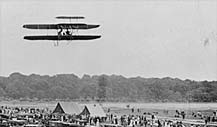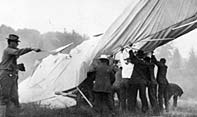 
Signal Corps Specification, No. 486
By late 1907, with negotiations in Europe
going well, the U.S. Army showed renewed interest in the Wright
brothers. Rather than directly offering them a contract, the
Board of Ordnance and Fortification and the U.S. Signal Corps
announced an advertisement for bids to construct an airplane.
However, the design and performance specifications were such
that the Wrights were the only viable bidder.
A price of $25,000 was set for the brothers’ airplane
if they could meet the performance criteria in actual flight
trials.
Fort Myer
The flight trials were scheduled for late
summer 1908 at Fort Myer, Virginia, a military post just outside
Washington, D.C. With the commitments in Europe, the brothers
had to separate for the first time. With Wilbur off to France,
Orville did the flying for the Army.
First fatality
On September 17, 1908, with Army observer
Lt. Thomas O. Selfridge on board, the airplane experienced
a mechanical malfunction involving one of the propellers and
crashed. Orville was severely injured and Selfridge died,
the first fatality in a powered airplane. Orville would resume
the flight trials after his recovery.
 
All Army requirements met
The Wrights returned to Fort Myer to complete
the Army trials after the homecoming celebrations in June
1909. Over several weeks, the Wrights fulfilled each requirement
in Signal Corps Specification No. 486. The final one was a
cross-country flight of 10 miles with a passenger. This flight
also served as the official speed trial. The contract stipulated
that they would receive a 10 percent bonus for every full
mile per hour above 40. Their average speed was 42.5 miles
per hour, which rewarded them with a $5,000 bonus and brought
the final purchase price of the airplane to $30,000.
Wright Military Flyer
The Wrights returned to Fort Myer in 1909
with an entirely new airplane. The Army purchased it that
year, used it to train pilots in the fall of 1909 and in 1910,
then donated it to the Smithsonian Institution in 1911 after
acquiring other aircraft. Designated Signal Corps No. 1 by
the Army, it is generally referred to as the Wright Military
Flyer and was the world’s first military airplane.
The Wrights and the U.S. Navy
Also interested in aviation, the U.S. Navy
purchased a Wright Model B airplane in 1911 and modified it
for water takeoff. However, the Navy preferred the aircraft
produced by Glenn Curtiss, who had designed airplanes specifically
for operating off water.
Got to Commercial Aviation >>
|

